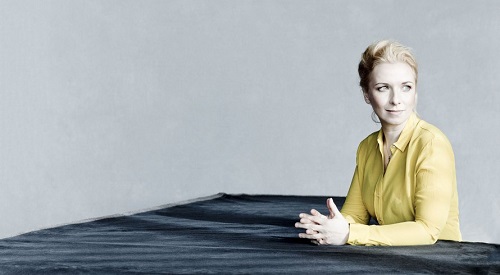 United Kingdom London Piano Festival – Bach, Rameau, and Messiaen: Tamara Stefanovich (piano). Hall One, Kings Place, London, 6.10.2022. (MB)
United Kingdom London Piano Festival – Bach, Rameau, and Messiaen: Tamara Stefanovich (piano). Hall One, Kings Place, London, 6.10.2022. (MB)

Bach – Aria variata alla maniera italiana, BWV 989
Messiaen – Préludes: ‘Chant d’extase dans un paysage triste’
Bach – Three-part Inventions: Sinfonia No.9 in F minor, BWV 795
Rameau – Pièces de clavecin: ‘L’entretien des muses’
Messiaen – Catalogue d’oiseaux: ‘Le courlis cendré’; Vingt regards sur l’enfant-Jésus: ‘Regard des anges’, ‘Première communion de la Vierge’
Rameau – Pièces de clavecin: ‘Les cyclopes’; Nouvelles suites de pièces de clavecin: ‘La poule’
Messiaen – Catalogue d’oiseaux: ‘L’alouette calandrelle’
Bach – Three-part Inventions: ‘Sinfonia No.15 in B minor, BWV 801
Messiaen – Vingt regards: ‘La parole toute puissante’, ‘Noël’; Cantéyodjayâ
I had found myself reflecting recently how sad it was that Olivier Messiaen’s music had somewhat gone out of fashion. It does not go unheard, but like that of many composers, the number of works regularly performed is not so great. There are advocates, of course, though perhaps fewer than would be ideal. The loss of Pierre Boulez continues to hit the cause of twentieth-century music hard and this is surely a case in point. Sometimes an anniversary offers an opportunity; alas, nothing significant is approaching. As Messiaen, then, finds himself in the doldrums, alongside figures such as Hindemith (how much longer?!) and Tippett, it was refreshing indeed to find his music so thoughtfully programmed and brilliantly performed as here by Tamara Stefanovich in the opening programme of this year’s London Piano Festival.
Bach, though not at his most familiar, began the recital: the Aria variata. Stefanovich’s rich-toned, deeply considered reading showed, should there have been any doubters, that performance with great insight into contemporary (to Bach) language and practice is perfectly possible on the piano. I fancied I heard her a little, or more than a little, of her stated admiration for Nikolaus Harnoncourt here. ‘French’ rhythms were strongly to the fore, already pointing the way not only to Rameau but, perhaps more strongly still, to Messiaen. With command of Bach’s rhetoric, Stefanovich employed variation form and the changes of perspective it wrought to fashion a powerful cumulative statement. Freedom and form were unmistakably two sides of the same coin.
Youthful Bach (c.1709) gave way to still more youthful Messiaen. The ‘Chant d’extase dans un paysage triste’ from his early Préludes captured the spirit of its poetic title with just the right sort of post-Debussyan voice. Ecstasy, as in much of what was to come, offered liberation in its ordered delirium; or was that an exquisite cage? Perhaps there was no need to choose. Nor was there, returning to Bach, in the darkly chromatic yearning of the F minor Sinfonia, a ‘black pearl’ of its own. Rameau offered a staging post in between, though with its own character. The difference of his conception of harmony — recall Emanuel Bach’s self-portrayal as ‘anti-Rameau’ — and indeed of ornamentation seemed in some ways closer to Messiaen, though these are not perhaps composers we most readily consider bedfellows. ‘L’entretien des muses’ was similarly well-shaped, dynamic contrasts very much part of that shaping. Two Messiaen pieces closed the first half: from Catalogue d’oiseaux: ‘Le courlis cendré’, and from Vingt regards sur l’enfant-Jésus: ‘Regard des anges’. Playful violence across the keyboard, not unlike a swerving cat, took us from deep chords and high birdsong to a further sweep of carolling colours and contrasts.
The second half opened with another ‘regard’, ‘Première communion de la Vierge’, which brought further heavenly ecstasy. Rock-solid rhythm enabled fantastic melodic arabesques to work their magic above; so too did harmony, Rameau’s ghost included. Two more of Rameau’s keyboard pieces, ‘Les cyclopes’ and ‘La poule’ followed, the former unfolding with grace and not entirely dissimilar fantasy, the former a study in pictorial caprice and obstinacy suggestive of another harpsichordist contemporary, Domenico Scarlatti. Indeed, great Scarlatti pianists came to my mind in the display and relish we heard for score and instrument alike. Repeated notes offered a strange yet convincing rainbow bridge between this and the next Messiaen piece, the second Bach Sinfonia in context effecting an almost Apollonian restoration of order.
Almost mocking in its apocalyptic vision, cutting us mere mortals down to size, ‘La parole toute puissante’ more than lived up to its name. This final Messiaen sequence, culminating in the extraordinary rhythms — and manifold implications — of Cantéyodjayâ, unleashed a torrential force of pianistic yet above all musical bravura. Weird, wonderful, above all unanswerable, this was music that played by — and was played with — its own rules, a crazy world of mysteries in itself that confirmed beyond doubt how much richer our own world is with the music of Messiaen.
Mark Berry
